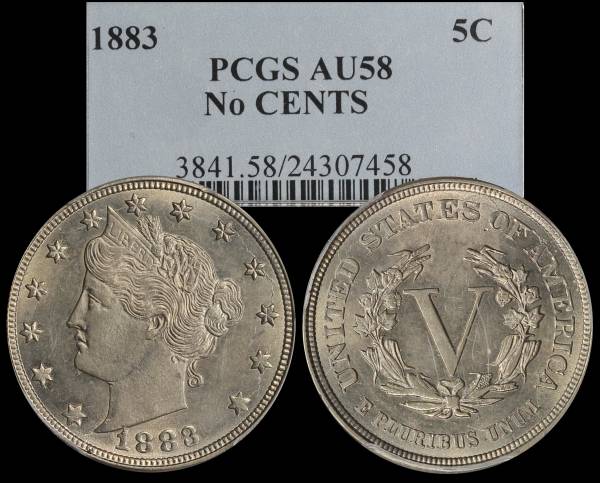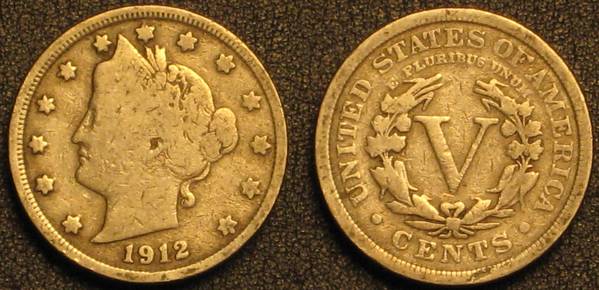Liberty Nickels For Sale
History of the Liberty Nickel
General
The Liberty Nickel, commonly known as the “V” nickel for the Roman Numeral "V" on the reverse was officially produced from 1883 to 1912. We use the word officially because one of the most famous coins of all is the 1913 Liberty Nickel which was produced under suspect circumstances. More on that later.
In 1881, A. Loudon Snowden, Superintendent of the Philadelphia Mint
directed Chief Engraver at the time, Charles Barber, to create designs
for the cent, three-cent piece and the nickel. Snowden believed that
all three coins should be similar in design and metal composition. The designs created by Barber were all simple in
appearance with Lady Liberty on the obverse and a Roman Numeral I, III
or V on the reverse to represent the denomination. Barber completed the
request later that year with all three coins stuck in copper-nickel
which was the same as the Shield Nickel currently in circulation. The
Shield Nickel, introduced in 1866, was the first “nickel” sized coin.
The half-dime, made of silver, had previously filled the need for this
denomination. The Shield Nickel was well received despite the fact that
during this time period, consumers liked their coinage in silver and/or
gold. And although the nickel was relatively new, its bland design made
it ripe for a redesign. Additionally, during this time period, there
was not yet a federal law establishing the minimum life expectancy for
US coin designs.
composition. The designs created by Barber were all simple in
appearance with Lady Liberty on the obverse and a Roman Numeral I, III
or V on the reverse to represent the denomination. Barber completed the
request later that year with all three coins stuck in copper-nickel
which was the same as the Shield Nickel currently in circulation. The
Shield Nickel, introduced in 1866, was the first “nickel” sized coin.
The half-dime, made of silver, had previously filled the need for this
denomination. The Shield Nickel was well received despite the fact that
during this time period, consumers liked their coinage in silver and/or
gold. And although the nickel was relatively new, its bland design made
it ripe for a redesign. Additionally, during this time period, there
was not yet a federal law establishing the minimum life expectancy for
US coin designs.
Changing the cent, three-cent piece and nickel was not to be. Congress opposed a change in composition to the cent and the Treasury would not approve a design change for the three-cent piece. The three-cent silver piece has been discontinued several years before and the three-cent nickel, with the exception of 1881 had seen declining mintage numbers. With the nickel seeming to be the only viable option for change, Barber and Snowden concentrated on making the change to the nickel a reality. In addition to a design/appearance change, Snowden also changed the size from 20.5 mm in diameter to 21.2 mm. Snowden believed that by increasing the diameter and reducing the thickness (the weight stayed the same), die life would be extended.
After all the finishing touches were complete, there was a special
ceremony on January 30th, 1883 to introduce the new nickel. Those who
attended, and were deemed important, received first strike coins. A few
days later, regular production began. The new nickels had hardly been
circulated when a major problem surfaced. The coin did not contain the
word “cents” and con artists of the day were plating the nickel with
gold and passing them off as $5.00 gold pieces. Because the nickel was still
new, the general public was not aware of the new nickel and since the
“V” was the only symbol of value, it could mean 5 cents or 5 dollars.
Unfortunately for the mint, nearly 5 � million nickels had already been
produced and released. Barber quickly created a new design, this one
with the word cents prominently displayed on the back. The first
nickels soon became known as the “no cents” nickels. The nickels that
were gold plated became known as “racketeer nickels” and can still be
found in old hoards and collections.
passing them off as $5.00 gold pieces. Because the nickel was still
new, the general public was not aware of the new nickel and since the
“V” was the only symbol of value, it could mean 5 cents or 5 dollars.
Unfortunately for the mint, nearly 5 � million nickels had already been
produced and released. Barber quickly created a new design, this one
with the word cents prominently displayed on the back. The first
nickels soon became known as the “no cents” nickels. The nickels that
were gold plated became known as “racketeer nickels” and can still be
found in old hoards and collections.
In the end, over 16 million nickels were produced in 1883. Even though far more 1883 nickels with the word “cents” were produced, they are harder to get in good grades. The “no cents” variety was saved by people thinking that they would be recalled/replaced.
After this initial controversy, the Liberty Nickel settled down to a calm life. There were no significant changes during the life span of the nickel, and for all but the final year, all the nickels were made in Philadelphia. In the final year of official production, 1912, nickels were also made in Denver and San Francisco.
Officially, Liberty Nickels were produced from 1883 to 1912. Sometime well after production stopped, a few 1913 Liberty Nickels surfaced. In December 1919, Samuel W. Brown put an advertisement in The Numismatist offering to pay $500 for 1913 Liberty Nickels. It is a known fact that he was the first person to advertise for this date. It turns out; Brown was employed by the mint at the time of the suspected minting of the 1913 coins. He worked in the coining department. Although no one now knows for sure how the 1913 coins were produced, there are a couple theories:
- It is speculated that the coins were produced in late 1912 when dies for the next years coinage were being made, and before it was decided that 1913 would be the introduction of the Buffalo Nickel.
- The coins could have been produced early January 1913. The first “experimental” Buffalo Nickels were struck on January 7th, 1913 but production did not take place until February 15, due to various design problems. It would not have been unusual for someone in the Medal Department of the Mint to strike a few examples for cabinet/display purposes. Since the Buffalo Nickel was not yet officially approved, striking a few Liberty Nickels would not have been illegal.
While no one knows for sure how Brown came into possession of the nickels, it is possible that he received them from engraver George T. Morgan, who produced rarities upon occasion for sale to dealers. Considering the effort required to produce them, such as making the dies, preparing the machinery and then finally striking the coins, it is amazing that no-one came forward to claim participation or to profit from the coins.
After running the ad, Brown displayed the nickels in 1920 at an ANA convention. Now the word was out, 1913 Liberty Nickels actually existed. A few years later, a prominent coin dealer of the time, B. Max Mehl or Fort Worth, TX, advertised to pay $50 a piece for a 1913 Liberty Head Nickel. He knew he would never get one though. He was a marketing genius and as a result of his advertisements, coin collecting became all the rage and his publication, Star Rare Coin Encyclopedia sold very well. People began checking there change in hopes of finding the coin. To this day though, only 5 have ever surfaced and it is believed that the five known, are the only ones in existence.
In January 1924, August Wagner, a Philadelphia coin dealer advertised for sale the five nickels presumably on behalf of Samuel Brown. From there, they have had a host of owners. Until recently, one of the 5 pieces (the Walton Coin) had been missing for 40 years. Mr. Walton-a dealer, would take his coin to shows along with a duplicate. On his way to a show he was killed in a car wreck and his coins were scattered on the roadside. His heirs did get his coins back, but were never sure if the coin they had was the fake or the original. A major dealership once called the real coin a fake. In 2003 at the ANA Show, the coin was authenticated by several experts and the mystery of the missing coin ended. It was also at this convention that all 5 1913 Liberty Nickels were displayed together for the first time since 1920.
How famous is the 1913 Liberty Nickel? It was the first coin to sell for over one-million dollars. It was also featured on the old show Hawaii Five-0.
Collectibility
General
The Liberty Nickel series makes a challenging, yet very doable, series to complete. Most of the nickels produced from 1900 on can be had for around a couple bucks in low grades. Nicer grades around the VF range could cost you $10.00 per coin.
Key/Semi Key Dates
In order to complete the series, three coins may give you trouble. The 1885, 1886 and 1912 S are the lowest mintage. The 1885 had a mintage of over 1.5 million but will still set you back at least $500 in a grade around G4. The 1886 had a mintage of 3.3 million and will cost around $250 in a G4 grade. The 1912-S specimen had the lowest mintage by far of just 238,000. As this was the first Liberty Nickel from San Francisco, as well as the last of the series, it was probably saved a little bit more than the older issues as it may have been recognized for its low mintage. Even with a mintage of just 1/6 of the most expensive 1885 piece, the 1912-S can be had for around $150 around a G4 grade. For more information on collecting Liberty Nickels visit www.coin-articles.com
Errors
Unlike many other coins, such as the Lincoln series, there are not any real errors to speak of in the Liberty Nickel series. Sure, there are a number of repunched dates, etc, but no double dies, overdates, etc.
Proofs
Collecting proofs in the Liberty Nickel series can be tough yet rewarding. Proofs were minted for every year of existence for the “V” nickel. Proofs in PR65 condition can run in the $500 plus range for most years with the 1885 running upwards of $1500. Production usually numbered in the thousands for each year, which was an unusually high number for the period
Vital Statistics Summary
No Cents Variety
- Designed by: Charles E. Barber
- Issue date: 1883 Composition:
- 75% copper, 25% nickel
- Diameter: 21.2 mm.
- Weight: 77.16 grains (5 grams)
- Edge: Plain
- Business strike mintage: 5,474,000
- Proof mintage: 5,219
Cents Variety
- Designed by: Charles E. Barber
- Issue dates: 1883-1913
- Composition: 75% copper, 25% nickel
- Diameter: 21.2 mm.
- Weight: 77.16 grains (5 grams)
- Edge: Plain
- Business strike mintage: 596,535,965
- Proof mintage: 79,923